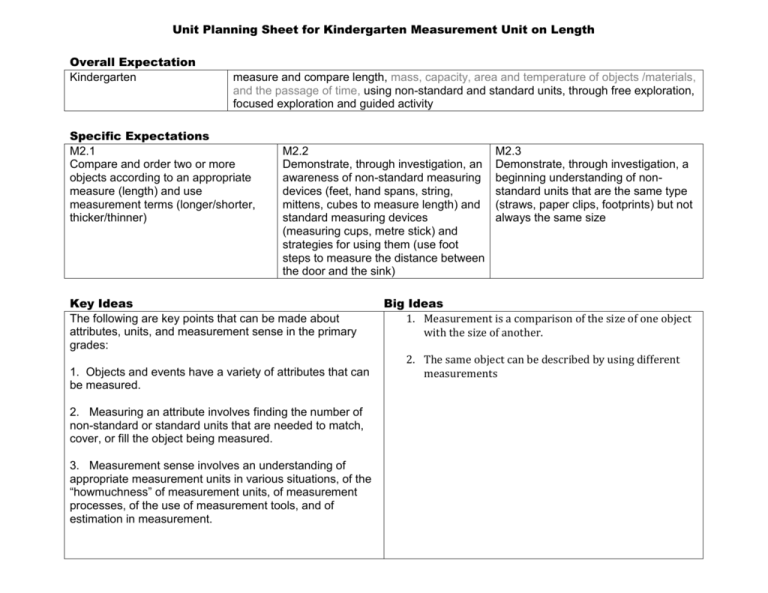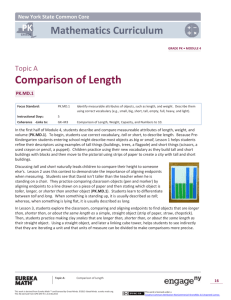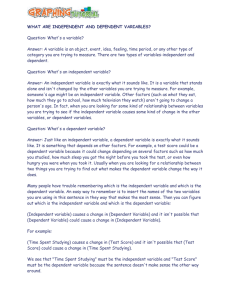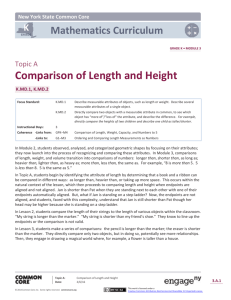Unit Planning Sheet for Kindergarten Measurement Unit
advertisement

Unit Planning Sheet for Kindergarten Measurement Unit on Length Overall Expectation Kindergarten measure and compare length, mass, capacity, area and temperature of objects /materials, and the passage of time, using non-standard and standard units, through free exploration, focused exploration and guided activity Specific Expectations M2.1 Compare and order two or more objects according to an appropriate measure (length) and use measurement terms (longer/shorter, thicker/thinner) M2.2 Demonstrate, through investigation, an awareness of non-standard measuring devices (feet, hand spans, string, mittens, cubes to measure length) and standard measuring devices (measuring cups, metre stick) and strategies for using them (use foot steps to measure the distance between the door and the sink) Key Ideas The following are key points that can be made about attributes, units, and measurement sense in the primary grades: 1. Objects and events have a variety of attributes that can be measured. 2. Measuring an attribute involves finding the number of non-standard or standard units that are needed to match, cover, or fill the object being measured. 3. Measurement sense involves an understanding of appropriate measurement units in various situations, of the “howmuchness” of measurement units, of measurement processes, of the use of measurement tools, and of estimation in measurement. M2.3 Demonstrate, through investigation, a beginning understanding of nonstandard units that are the same type (straws, paper clips, footprints) but not always the same size Big Ideas 1. Measurement is a comparison of the size of one object with the size of another. 2. The same object can be described by using different measurements Rationale In our FOS Measurement is an area of weakness. Measurement is used naturally to compare objects, discuss distance, temperature and time. Success Criteria and Misconceptions Success Criteria I can compare objects to determine their length or height I can measure length by lining the objects up next to each I can measure objects by using my foot print I can measure objects by using string, links, cubes, straws I can count the number of cubes to see how long the object is I need to use the same tool (manipulative) when measuring when Length of an object can be described differently when using different tools to measure (big/small foot print) Length is the most visible attribute of many objects, and is one of the first attributes discovered by children. In everyday situations, children explore the attribute of length in objects in their environment. Misconceptions o use different size units to measure an object o leave gaps or overlap o the object length stays the same size even if you use different measures and get different numerical values o objects need to be lined up evenly to measure correctly o measure in full units only, do not account for fractional measurements (Based on Marian Small’s ) Inquiry Question: What measurement tasks help students to choose the most appropriate tool to measure that object? Tools: cubes, links, straws, string, mittens, footprints Strategies Strategies Specific to Length: - comparison - count the cubes - use logical reasoning Problem Solving Strategies - understand the problem - choose a strategy - solve the problem - does my answer make sense Lesson Before Activating Prior Knowledge Diagnostic We know that the words longer and LG: Determine what shorter tell us about the students naturally how long or how tall know about measuring something is. length. Today I want you to Do they compare? find the length of Do they use a some objects. I am manipulative? going to ask to find the Do they use length of different *transitivity? items, dolls, lines and snakes. Transitivity If A is related to B and B is related to C, Then A is also related to C Materials: Dolls Snakes Inverted T Cubes Links During Hands On Working On It Dolls Maria thinks Susie is taller than Bridgette. Jeff thinks they are the same height. Who is right? The Inverted T Do you think the orange line is as long as the purple line, or is the orange line longer than the purple line? Snakes Which snake is longer? Strategies: Guess and Check Comparison Transitivity Tools: String Cubes Links Ruler After Congress Discussion Diagnostic – no discussion. These activities will be repeated using different materials as a culminating task to determine if the students are now able to use different strategies and tools. Good Questions Who was right about the dolls, Maria who thought Bridgette was taller or Jeff, who thought Bridgette and Susie were the same height? How did you find out if the lines were the same length or if the purple line was longer or the orange line was longer? How do you know which snake is longer? Lesson # 1 M2.1 Compare/order Footprints LG: Students use the language of longer/shorter, the same as LG: students use direct comparison to determine items longer, shorter, the same as Materials: Student’s shoe Before Activating Prior Knowledge Everyone look at your shoe. Compare your foot to the person sitting next you. During Hands On Working On It Small Group Activity Have each student take off one shoe and look for things in the What is the same classroom that are about your shoes? shorter, the same length and longer than What is different about their shoe. your shoes? Observations: Create a T Chart about how the shoes are the same and different After Congress Discussion Have one student show an item that was longer than their shoe. Good Questions Ask how do you know it is longer? How do you know that the item was longer than your shoe? What was harder to find, items that were longer, shorter or the same length? Why? After Practice: Have groups of five students order their shoes from shortest to longest. How do you know that the item was shorter than your shoe? How do you know that the item is as long as your shoe? Lesson # 2 M2.2 M2.3 (non-standard) More Footprints LG: Do not leave gaps between units when measuring LG: The same object can be described using different measurements Materials Multiple copies of: My footprint Zaid’s footprint Alyana’s footprint Ethan’s footprint Misconceptions: - use different size units to measure an object - leave gaps or overlap Before Activating Prior Knowledge Large Group: Gather the students in a circle. Put out the long block from the Big Blocks Centre. Have multiple copies of my footprint and Zaid’s footprint out. Ask a student to measure the length of the block. Talk about placement of the footprints, discuss that they cannot leave gaps. During Hands On Working On It Small Group Activity: After Congress Discussion Have each group discuss why they have Show the students two different answers. If different size footprints we are measuring (Alyana – small, Ethan something then it – large). should be the same? Pair the students, give one group Ethan’s foot print and have them measure the distance from one end of the carpet to the other. Give another pair, Alyana’s footprint and have them measure the same distance. Talk about the choice of footprints, only one Observations: size can be used not a - Use of language combination of Zaid’s prints and mine. Do they line up the items? - Do they understand larger print/smaller answer? Why is the answer less with Ethan’s footprint? Why is the answer longer with Alyana’s footprint? Good Questions Why don’t you want to leave gaps? Why did we get different answers when measuring the same block. Why do we line up the footprint with the end of the block? What did you do if there was some block left? Same type of tool/manipulative not the same size. Lesson # 3 Guide to EI Measurement p.56 M2.1 (compare) LG: Develop vocabulary for height (tall/short) LG: Compare objects according to an appropriate measure Materials: String cut in to lengths of one meter. Picture of the Ferris wheel. Before Activating Prior Knowledge Show the picture of the Ferris Wheels. During Hands On Working On It Which Ferris Wheel can you ride on? It is very important for people to be safe when they ride the Ferris wheel. There are two Ferris wheels at a fair. The small Ferris wheel is safe for people who are shorter that the string, and the big Ferris wheel is for people who are the same height of taller than the string. Are you taller, shorter or the same height as the string? Two students hold the Cards labeled Taller / Shorter / Same string end to end (vertically) from the Height floor. Ask: Do you think you are taller than, shorter than, or the same height as the string? Point up (taller) Point down (shorter) Point forward (same) Ask someone taller to stand beside to compare. Have students verify yes/no Students work in groups of 3. Tell students they need to work together to compare themselves by height with the piece of string. Explain that each student needs to find out whether he or she is taller than, or the same height as the piece of string. After Congress Discussion Ask a few students to show how they determined whether they were taller, shorter or as tall as the string. Good Questions Show the students the cards labeled Shorter/Taller/Same Height. Are you taller, shorter or the same length? How do you know? Discuss the meaning of each word on the card. Place the cards on the floor. Ask each student to line up behind the card that describes their height in relation to the piece of string. Explain that we have created a graph. Observe: Use of language Short/tall Tall/taller Use of comparing strategy Can they explain how to measure? Which group has the fewest? Which group has the most? Are more students taller/shorter/same as String? What are you measuring? How are you using the piece of string to measure? If you were at the fair, could you ride the small Ferris wheel or the big Ferris wheel? Why? Graph Questions: What does our people graph show? Which students would be able to go on the big Ferris wheel? Which students would be able to go on the small Ferris wheel? What do all these students have in common? How many students are taller than the string? Shorter/same? Lesson # 4 M2.1 Student Line Up LG: vocabulary for height (tall/short) LG: compare objects according to an appropriate measure Materials none Lesson # 5 M2.1 LG: vocabulary for height (tall/short) LG: compare objects according to an appropriate measure Before Activating Prior Knowledge Have Ms. Vanetti, Ms. Hassan and Ms. Deborta model how to determine who is taller. And then have them order themselves so they are standing from shortest to tallest. Model the language of transitivity. If Ms. Deborta is taller than Ms. Vanetti and Ms. Vanetti is taller than Ms. Hassan then we know that Ms. Deborta is taller than Ms. Hassan without having to measure because Ms. D is taller than Ms. V who we know is taller than Ms. Hassan Before Activating Prior Knowledge Ask two students to hold the string at each end and model how to use the string to measure. During Hands On Working On It Order yourselves from shortest to the tallest. Break the students up into groups of 5 and have them place themselves in order from shortest to the tallest. Observations: Use of language Short/tall Tall/taller Use of comparing strategy After Congress Discussion Have each group show to the class their order. Have one person explain how they figured out where each student was placed? Extension: Determine how many snap cubes long the shortest person in your group is. Good Questions How did you know who was the shortest? How did you measure if two students were about the same height? How did you know who was the tallest? Could you measure another way? How many snap cubes long is the tallest person? Can they explain how to measure? How many snap cubes taller are they than the shortest person in your group. During Hands On Working On It Students work in pairs to find items in the class or around the school that are shorter, longer than or the same length. After Congress Discussion Ask several students to present their findings. Good Questions How do you know it is longer/shorter/same as the string? Lesson # 6 M2.1 Growing Tall LG: vocabulary for height (tall/short) LG: compare objects according to an appropriate measure LG: Make estimations Materials Green strips of construction paper leafs tape Before Activating Prior Knowledge Have 4 students to come up and put themselves in order from shortest to tallest. During Hands On Working On It Small Group Activity Tape three stems to the wall so they are extended vertically from the floor. Remind students of Provide each student the strategies they can with a paper leaf and use to order have the student print themselves their name on the leaf. - stand side by side - stand back to back Ask the student to - get a piece of string look at the stem and - use a metre stick to estimate whether - use links to measure they are closest in height to the first, second or third stem. Have them place their leaf on the floor in front of the stem. Have each student stand in front of the stem and have the group decide which stem is closest to the student’s height. Determine whether the student estimated correctly when placing the leaf. Tape name on to the stem closest to height. After Congress Discussion Looking at the stems can you tell who the tallest student in the class is? Why not? How can you tell by looking at the plants, that Linkyn is approximately the same height as Maxim? How can you tell Manahil is taller than Savi? Is Dimitrije taller than Ocean? Good Questions Why did you choose that stem? Could you choose the shortest stem? Why or why not? If you are taller than Angad are you taller than Alyana? How do you know? Lesson # 7 M2.2 (non-standard) Building Towers LG: vocabulary for height (tall/short, longer/shorter) LG: compare objects according to an appropriate measure LG: Make estimations Before Activating Prior Knowledge Have the students sit in a circle. Show the students several cones stacked. Tell them I want to measure how tall the structure is. Can someone choose a manipulative that they think will best measure the tower? During Hands On Working On It Using snap cubes have the students build a tower that is shorter than the object they chose (i.e., juice container). Count the number of cubes and record. Build a tower that is the same height as the container. How many cubes? Why did you choose that manipulative? Materials: Recording Sheet Links it Cubes Cones Water bottles Juice jugs Juice containers Paint containers Metre stick String Is there another manipulative that will work better? Build a tower that is taller as the container. How many cubes did you use? After Congress Discussion Display several of the towers the students built. Good Questions Have students estimate how blocks were used to build each tower. How many did you use to make your tower shorter? How many cubes did you use to make your tower taller? How many more did Discuss which tower is you use in the taller taller. How do you tower than the shorter know? tower? Encourage the students to count the cubes to determine which is taller. Use vocabulary of _______ tower is 3 cubes taller than _______ tower. 5 and 3 is 8. Lesson # 8 M2.1 M2.3 Compare/order Mittens LG: Students use the language of longer/shorter, the same as LG: Students use direct comparison to determine items longer, shorter, the same as Materials: Student’s mittens Before Activating Prior Knowledge Everyone get one of your mittens. Compare your mitten to the person sitting next to you. What is the same about your mittens? What is different about your mittens? Create a T Chart about how the mittens are the same and different During Hands On Working On It Have each student look for things in the classroom that are shorter, the same length and longer than their mitten. After Congress Discussion Have one student show an item that was longer than their mitten. Ask how do you know it is longer? Good Questions How do you know that the item was shorter than your mitten? How do you know that the item was longer than your mitten? Observations: What was harder to find, items that were longer, shorter or the same length? Why? After Practice: Have student in groups of 5 order their mittens from shortest to longest. After Practice: Have the students measure the same object using two different size mittens How do you know that the item is as long as your mitten? Why when you measure the same item with two different mittens do you get different answers? Lesson # 9 M2.1 M2.2 Compare/nonstandard The Mitten Before Activating Prior Knowledge During Hands On Working On It After Congress Discussion Good Questions Read the book The Mitten to the students. How many mittens tall are you? How many mittens tall are you? LG: Do not leave gaps between units when measuring Remind the students that yesterday we used our mittens to measure things in the classroom that were shorter, the same length and longer than our mittens. Students will use the mitten strips to determine how many mittens tall they are. Have several students come and show how they measured and tell how many mittens tall they are. LG: The same object can be described using different measurements Materials Shrink and photocopy mittens linked together They will have to lay the mittens strips down next to one another as the strips will not be long enough to measure. Observations: Do they leave gaps when measuring? Do they count the number of mittens to determine how many mittens tall they are? Do they use 5 as an anchor when counting? How do you know? How much taller are you than ______? How do you know? What strategy did you use? Scarves: Have a few scarves of different lengths. Some of the scarves can be coiled up. The students must determine which scarf is the longest, shortest, etc. Purpose: Does the student choose an appropriate tool to measure the lengths of the scarves? Does the student use a direct comparison of the scarves. Lesson # 10 M2.2 non-stand Carpet LG: Do not leave gaps between units when measuring LG: The same object can be described using different measurements Before Activating Prior Knowledge Today, I want you to measure the length of the carpet from the green circle to the red circle. You can choose any manipulative you like (footprints, mittens, cubes, links, string, straws). Remind the students: When we measure we cannot leave any gaps, the manipulative must touch the one before it and the one after. During Hands On Working On It Have the students work in groups of 2 or individually to measure the carpet. During Hands On Working On It Choose several students to show how they measured. Ask: What manipulative did you choose? Observation: Are they using math language? (longer, shorter, gaps) Are they counting the number of units to track how long the distance is? Do they complete the task? Do they change the manipulative? Do they challenge themselves to try a second manipulative? Was that a good choice? Why? Good Questions You used footprints and __________ used mittens why did you have fewer footprints then _________ had mittens? Is the length still the same even though you got different answers? How do you know? Lesson # 11 M2.2 non-standard Stuffy Measurement Party LG: Do not leave gaps between units when measuring LG: The same object can be described using different measurements LG: Students use the language of longer/shorter, the same as Before Activating Prior Knowledge Activities: Sort stuffed animals according to: Species Size (big/medium/small) Features During Hands On Working On It Visit to the doctor’s office: Stuffed animal is weighed Measured for height Waist is measured Order (small to tall) Visit to Vet/Doctor Measure length with cubes, links, mittens Measure belly – what is the best manipulative Name: Weighs ____ cubes. ______ mittens tall. Waist ____ links LG: students use direct comparison to determine items longer, shorter, the same as ______ is a healthy weight for a ______. Prescription: ____ needs _____ hugs a day. During Hands On Working On It Good Questions Culminating Task Put out two objects a teddy bear and doll from the home centre. Say to the students: Ms. Hassan thinks the doll is taller but I think the bear and the doll are the same height. Assessment: Can they compare the bears; 1. 2. 3. 4. Direct Comparer Indirect Comparer (string or 3rd object) Orderer Measurer (non standard units) Who is right? How do you know? The students can use the links to measure or they can directly compare the objects. The Inverted T Do you think the orange line is as long as the purple line, or is the orange line longer than the purple line? Place the objects in order from shortest to tallest Find an object taller, shorter, the same length as Assess use of language: Consistently uses shorter/taller, longer/shorter/same as Able to choose the best manipulative to measure an object and explain why? Does not leave gaps when measuring objects. Strengths & Weaknesses Unit Strengths of Length Students were exposed to wide variety of manipulatives - foot prints, mittens, snap cubes, links Unit Weaknesses of the Length Unit Not able to grasp the concept of transitivity Reverted to ordering rather than choosing a unit Hands on activities that engaged the students Many opportunities to measure and consolidate on the big ideas of Measurement is a comparison of the size of one object with the size of another. The same object can be described by using different measurements Students were able to understand concept of not leaving gaps between the manipulatives Able to choose appropriate manipulative to measure a variety of objects Able to use direct comparison to determine who was taller in a group and order the students Ah Moments: - JK students although younger were taller than a SK student Able to choose an appropriate manipulative but then did not count the number of cubes/links/mittens to determine the length of the object (counting issues) Getting students to understand the difference between height and length – use of vocabulary Height and length More Cross Curricular – data management – graphing the results of heights Venn Diagrams 1. A) What types of measurement have we observed our students using during play this year? (e.g. blocks, water, sand) Naturally Students: - Compared lengths - Counted the number of scoops of sand or water to fill a container - able to compare size – small, medium, big - able to determine which block was heavier based on size 2. What measurement tasks help students to determine which tools to use to best measure an object? (Length: ruler, measuring tape, straws, string, paper clips, foot prints, hand prints, link cubes, snap cubes). Having students build and independently choose a manipulative to determine the height/length Have students compare manipulatives to determine which manipulative was the best to use and why During independent play time students chose to measure objects and justified why they used that manipulative 3. What Math and Language strands and processes are students using to solve the measurement tasks (Data Management, Patterning, Number Sense, Geometry, logical reasoning, problem solving)? Math Processes: Problem solving Reasoning and Proving Representing Communicating Reflecting Language: Prediction – what manipulative to use Writing – list to order students from shortest to tallest Math Strands Number Sense: Estimation Counting Geometry – what unit is best to use to measure certain objects because of the shape







